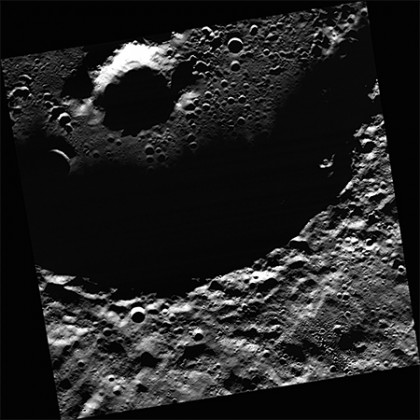NASA's Messenger spacecraft has provided the first optical images of ice and other frozen volatile materials within permanently shadowed craters near Mercury's north pole. The images not only reveal the morphology of the frozen volatiles, but they also provide insight into when the ices were trapped and how they've evolved, according to an article published Wednesday in the journal Geology.

Image caption: Prokofiev, named in August 2012 for the Russian composer, is the largest crater in Mercury’s north polar region to host radar-bright material.
Image credit: NASA/Johns Hopkins University Applied Physics Laboratory/Carnegie Institution of Washington
Two decades ago, Earth-based radar images of Mercury revealed the polar deposits, which scientists postulated consisted of water ice. That hypothesis was later confirmed by Messenger through a combination of neutron spectrometry, thermal modeling and infrared reflectometry.
"But along with confirming the earlier idea, there is a lot new to be learned by seeing the deposits," said lead author Nancy Chabot, the Instrument Scientist for Messenger's Mercury Dual Imaging System (MDIS) and a planetary scientist at the Johns Hopkins University Applied Physics Laboratory.
Beginning with Messenger's first extended mission in 2012, scientists launched an imaging campaign with the broadband clear filter of MDIS's wide-angle camera. Although the polar deposits are in permanent shadow, through many refinements in the imaging, the camera was able to obtain images of the surfaces of the deposits by leveraging very low levels of light scattered from illuminated crater walls. "It worked in spectacular fashion," Chabot said.
The team zeroed in on Prokofiev, the largest crater in Mercury's north polar region found to host radar-bright material.
"One of the big questions we've been grappling with is 'When did Mercury's water ice deposits show up?' Are they billions of years old, or were they emplaced only recently?" Chabot said. "Understanding the age of these deposits has implications for understanding the delivery of water to all the terrestrial planets, including Earth."
Overall, the images indicate that Mercury's polar deposits either were delivered to the planet recently or are regularly restored at the surface through an ongoing process.
Tagged applied physics laboratory, nasa, space, messenger









